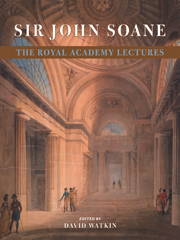Lecture III
from The Royal Academy Lectures
Published online by Cambridge University Press: 12 October 2018
Summary
MR PRESIDENT, - Having in the last lecture shown many different examples of the three Grecian orders, the Tuscan and Composite are now to be considered.
It has been generally supposed that the Tuscan order was first used in the Grecian colony ofEtruria. It is also recorded that in the most early period of Rome the Etrurians had so much distinguished themselves by their taste and knowledge of the arts in general and of architecture in particular, that when Tarquinius Superbus proposed to erect a temple to Jupiter, workmen were procured for that purpose from Etruria, Rome not possessing at that time any competent to the undertaking.
The buildings wherein the Tuscan order was used, being from necessity constructed chiefly of timber, we have no remains of them; and it is therefore to Vitruvius we must refer for information on the subject as far as relates to the entire order. According to this great architect, the Tuscan column should be seven diameters high, and the diminution one fourth part of its diameter; and over the columns beams, or architraves, are to be laid of the same thickness as the hypotrachelium at the top of the column; and over these beams mutules are placed projecting one fourth of the entire height of the column. This great projection for a long time perplexed all his commentators, and many ingenious suggestions were unsuccessfully formed to reconcile the text of Vitruvius with their different ideas of his meaning. Inigo Jones, however, in the church of St. Paul, Covent Garden, has fully explained the intention of Vitruvius and established the correctness of his text. The proportions used by Inigo Jones in this justly celebrated work correspond most admirably with the precepts of Vitruvius.
The Composite or Roman order is now to be considered.
- Type
- Chapter
- Information
- Sir John Soane: The Royal Academy Lectures , pp. 63 - 88Publisher: Cambridge University PressPrint publication year: 2000



